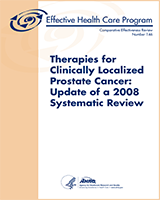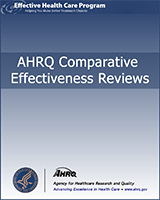NCBI Bookshelf. A service of the National Library of Medicine, National Institutes of Health.
Excerpt
This report summarizes evidence comparing the relative effectiveness and safety of treatment options for clinically localized prostate cancer. The report addresses the following questions: 1) What are the comparative risks, benefits, short- and long-term outcomes of therapies for clinically localized prostate cancer? 2) How do specific patient characteristics, e.g., age, race/ethnicity, presence or absence of comorbid illness, preferences (e.g., tradeoff of treatment-related adverse effects vs. potential for disease progression), affect the outcomes of these therapies, overall and differentially? 3) How do provider/hospital characteristics affect outcomes overall and differentially (e.g., geographic region and volume)? 4) How do tumor characteristics, e.g., Gleason score, tumor volume, screen vs. clinically detected tumors, affect the outcomes of these therapies, overall and differentially?
Contents
- Preface
- Acknowledgments
- Executive Summary
- 1. Introduction
- 2. Methods
- 3. Results
- Key Question 1: What are the comparative risks, benefits, short- and long-term outcomes of therapies for clinically localized prostate cancer?
- Overview of Studies
- Results by Comparison
- Key Question 2: How do specific patient characteristics, e.g., age, race/ ethnicity, presence or absence of comorbid illness, preferences (e.g., tradeoff of treatment-related adverse effects vs. potential for disease progression) affect the outcomes of these therapies, overall and differentially?
- Key Question 3: How do provider/hospital characteristics affect outcomes overall and differentially (e.g., geographic region and volume)?
- Key Question 4: How do tumor characteristics, e.g., Gleason score, tumor volume, screen vs. clinically detected tumors, and PSA levels, affect the outcomes of these therapies, overall and differentially?
- 4. Summary Table
- 5. Discussion
- Abbreviations
- Appendixes
Prepared for: Agency for Healthcare Research and Quality, U.S. Department of Health and Human Services.1 Contract No. 290-02-0009. Prepared by: Minnesota Evidence-based Practice Center.
Suggested citation:
Wilt TJ, Shamliyan T, Taylor B, MacDonald R, Tacklind J, Rutks I, Koeneman K, Cho C-S, Kane RL. Comparative Effectiveness of Therapies for Clinically Localized Prostate Cancer. Comparative Effectiveness Review No. 13. (Prepared by Minnesota Evidence-based Practice Center under Contract No. 290-02-0009.) Rockville, MD: Agency for Healthcare Research and Quality, February 2008. Available at:http://effectivehealthcare.ahrq.gov/healthInfo.cfm?infotype=all&reptype=allfinal
None of the investigators has any affiliations or financial involvement that conflicts with the material presented in this report.
This report is based on research conducted by the Minnesota Evidence-based Practice Center (EPC) under contract to the Agency for Healthcare Research and Quality (AHRQ), Rockville, MD (Contract No. 290-02-0009). The findings and conclusions in this document are those of the authors, who are responsible for its contents; the findings and conclusions do not necessarily represent the views of AHRQ. Therefore, no statement in this report should be construed as an official position of the Agency for Healthcare Research and Quality or of the U.S. Department of Health and Human Services.
This report is intended as a reference and not as a substitute for clinical judgment. Anyone who makes decisions concerning the provision of clinical care should consider this report in the same way as any medical reference and in conjunction with all other pertinent information.
This report may be used, in whole or in part, as the basis for development of clinical practice guidelines and other quality enhancement tools, or as a basis for reimbursement and coverage policies. AHRQ or U.S. Department of Health and Human Services endorsement of such derivative products may not be stated or implied.
- 1
540 Gaither Road, Rockville, MD 20850. www
.ahrq.gov
- Review Therapies for Clinically Localized Prostate Cancer: Update of a 2008 Systematic Review[ 2014]Review Therapies for Clinically Localized Prostate Cancer: Update of a 2008 Systematic ReviewSun F, Oyesanmi O, Fontanarosa J, Reston J, Guzzo T, Schoelles K. 2014 Dec
- Histopathological prostate cancer characteristics at radical prostatectomy after population based screening.[J Urol. 2000]Histopathological prostate cancer characteristics at radical prostatectomy after population based screening.Hoedemaeker RF, Rietbergen JB, Kranse R, Schröder FH, van der Kwast TH. J Urol. 2000 Aug; 164(2):411-5.
- Outcomes of initially expectantly managed patients with low or intermediate risk screen-detected localized prostate cancer.[BJU Int. 2012]Outcomes of initially expectantly managed patients with low or intermediate risk screen-detected localized prostate cancer.Bul M, van den Bergh RC, Zhu X, Rannikko A, Vasarainen H, Bangma CH, Schröder FH, Roobol MJ. BJU Int. 2012 Dec; 110(11):1672-7. Epub 2012 Aug 29.
- Decision analysis using individual patient preferences to determine optimal treatment for localized prostate cancer.[Cancer. 2007]Decision analysis using individual patient preferences to determine optimal treatment for localized prostate cancer.Sommers BD, Beard CJ, D'Amico AV, Dahl D, Kaplan I, Richie JP, Zeckhauser RJ. Cancer. 2007 Nov 15; 110(10):2210-7.
- Review Benefits and Harms of Prostate-Specific Antigen Screening for Prostate Cancer: An Evidence Update for the U.S. Preventive Services Task Force[ 2008]Review Benefits and Harms of Prostate-Specific Antigen Screening for Prostate Cancer: An Evidence Update for the U.S. Preventive Services Task ForceLin K, Lipsitz R, Janakiraman S. 2008 Aug
- Comparative Effectiveness of Therapies for Clinically Localized Prostate CancerComparative Effectiveness of Therapies for Clinically Localized Prostate Cancer
- C45G9.5 Uncharacterized protein [Caenorhabditis elegans]C45G9.5 Uncharacterized protein [Caenorhabditis elegans]Gene ID:175686Gene
- dph-2 2-(3-amino-3-carboxypropyl)histidine synthase subunit 2 [Caenorhabditis el...dph-2 2-(3-amino-3-carboxypropyl)histidine synthase subunit 2 [Caenorhabditis elegans]Gene ID:174649Gene
Your browsing activity is empty.
Activity recording is turned off.
See more...

